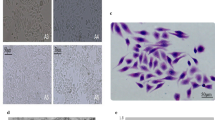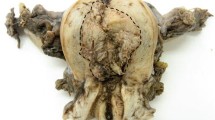Abstract
A new cell line designated as BCS-TC2 was established in culture from a primary human colon adenocarcinoma. This cell line has been in continuous culture over a 36-month period. The cells grow as a monolayer sheet, displaying areas with a multilayered pattern as well as single cells and free-floating aggregates. The morphological, immunological, and ultrastructural features of these cells are in agreement with their epithelial origin. The characterization of this cell line indicated a 38 hr doubling time, and a colony forming efficiency of 2% in semisolid media and 22% in liquid culture, at low cell densities. These cells produce low amounts of carcinoembryonic antigen in culture (0.1 ng of CEA/106 cells). Sub-cutaneous injection into athymic mice shows that these cells have a non-tumorigenic capacity. Chromosomal analysis showed a karyotype 46 XX,-15, +der (15), inv (16) (p13::q13). BCS-TC2 cell line, which maintains in culture several characteristics of the original tumor, represents a useful model system for cell biology studies of primary and non-metastatic tumors.
Similar content being viewed by others
References
Banks-Schlegel SP and Quintero J (1986) Growth and differentiation of human esophageal carcinoma cell lines. Cancer Res. 46: 250–258.
Brattain MG, Levine AE, Chakrabarty S, Yeoman LC, Willson JKV and Long B (1984) Heterogeneity of human colon carcinoma. Cancer. Metast. Rev. 3: 177–191.
Cibas ES, Corson JM and Pinkus GS (1987) The distinction of adenocarcinoma from malignant mesothelioma in cell blocks of effusions. Hum. Path. 18: 67–74.
Coffey RJ, Goustin AS, Soderquist AM, Shipley GD, Wolfshonl J, Carpenter G and Moses HL (1987) Transforming growth factor α and β expression in human colon cancer lines: implications for an autocrine model. Cancer Res. 47: 4590–4594.
Drewinko B, Yang LY, Leibovitz A, Barlogie B, Lutz D, Jansson B, Stragand JJ and Trujillo JM (1984) Cellular discriminants for a biological classification of human colon carcinoma. Cancer Res. 44: 4241–4253.
Fernández-Sousa JM, Gavilanes JG, Municio AM, Pérez-Aranda A and Rodriguez R (1977) Lysozyme from the insect Ceratitis capitata eggs. Eur. J. Biochem. 72: 25–33.
Fett JW, Lobb RR, Alderman EM and Key ME (1986) Immunocytochemical and enzymatic detection of lysozyme in human colon carcinoma cell lines. Experientia 42: 1159–1162.
Kimball PM and Brattain MG (1980) Isolation of a cellular subpopulation from a human colonic carcinoma cell line. Cancer Res. 40: 1574–1579.
Kobori O, Martin F, Martin M and Turc C (1979) Establishment of a cell culture line from a transplantable rat stomach cancer induced by N-methyl-N′-nitro-N-nitrosoguanidine. Cancer Res. 39: 5141–5146.
Leibovitz A, Stinson JC, McComombs WB, McCoy CE, Mazur KC and Mabry ND (1976) Identification of human colorectal adenocarcinoma cell lines. Cancer Res. 36: 4562–4569.
Lizarbe MA, Olmo N and Gavilanes JG (1987a) Outgrowth of fibroblasts on sepiolite-collagen complexes. Biomaterials 8: 35–37.
Lizarbe MA, Olmo N and Gavilanes JG (1987b) Adhesion and spreading of fibroblasts on sepiolite-collagen complexes. J. Biomed. Mater. Res. 21: 137–144.
Lubs HA (1970) The clinical significance of chromosomal abnormalities in colonic cancer. In: W.J. Burdette (ed.) Carcinoma of the colon and antecedent epithelium. pp. 319–332. Charles C. Thomas. Springfield, Illinois.
Noguchi P, Wallace R, Johson J, Early EM, O'Brien S, Ferrone S, Pellegrino MA, Milstein J, Needy C, Browne W and Petricciani J (1979) Characterization of WiDr: a human colon carcinoma cell line. In vitro 15: 401–408.
Olmo N, Lizarbe MA, Turnay J, Mueller KP and Gavilanes JG (1988) Cell morphology, proliferation and collagen synthesis of human fibroblasts cultured on sepiolite collagen complexes. J. Biomed. Mater. Res. 22: 257–270.
Park JG, Oie HK, Sugarbaker PH, Henslee JG, Chen TR, Johnson BE and Gazdar A (1987) Characteristics of cell lines established from human colorectal carcinoma. Cancer Res. 47: 6710–6718.
Pavelic K, Bulbul MA, Slocum HK, Pavelic ZP, Rustum YM, Niedbala MJ and Bernacki RJ (1986) Growth of human urological tumors on extracellular matrix as a model for the in vitro cultivation of primary human tumor explants. Cancer Res. 46: 3653–3662.
Quinn LA, Moore GE, Morgan RT and Woods LK (1979) Cell lines from human colon carcinoma with unusual cell products, double minutes, and homogeneous staining regions. Cancer Res. 39: 4914–4924.
Rutzky LP (1985) The biology of human colon tumor cells in culture. Advances Cell Culture 4: 47–83.
Semple TU, Quinn LA, Woods LK and Moore GE (1978) Tumor and lymphoid cell lines from a patient with carcinoma of the colon for a cytotoxicity model. Cancer Res. 38: 1345–1355.
Siddiqui KM and Chopra DP (1984) Primary and long term epithelial cell cultures from human fetal normal colonic mucosa. In vitro 20: 859–868.
Shi ZR, Tsao D and Kim YS (1983) Subcellular distribution synthesis and release of carcinoembryonic antigen in cultured human colon adenocarcinoma cell lines. Cancer Res. 43: 4045–4049.
Tom BH, Rutzky LP, Jakstys HM, Oyasu R, Kaye CI and Kahan BD (1976) Human colonic adenocarcinoma cells. I. Establishment and description of a new line. In vitro 12: 180–191.
Trainer DL, Kline T, McCabe FL, Faucette LF, Feild J, Chaikin H, Anzano M, Rieman D, Hoffstein S, Li DJ, Gennaro D, Buscarino C, Lynch M, Poste G and Greig R (1988) Biological characterization and oncogene expression in human colorectal carcinoma cell lines. Int. J. Cancer 41: 287–296.
Verstijnen CPHJ, Arender JW, Moerkerk PTM, Geraedts JPM, Sekigawa K, Vitedaal MP and Bosman FT (1987) The establishment and characterization of two new cell lines derived from a single human colonic adenocarcinoma. Virchows Arch. B. 53: 191–197.
Whitehead RH, Macrae FA, St John JB and Ma J (1985) A colon cancer cell line (LIM 1215) derived from a patient with inherited nonpolyposis colorectal cancer. JNCI 74: 759–765.
Author information
Authors and Affiliations
Rights and permissions
About this article
Cite this article
Turnay, J., Olmo, N., Gavilanes, J.G. et al. Establishment and characterization of a new human colon adenocarcinoma cell line: BCS-TC2. Cytotechnology 3, 75–88 (1990). https://doi.org/10.1007/BF00365268
Received:
Accepted:
Issue Date:
DOI: https://doi.org/10.1007/BF00365268




